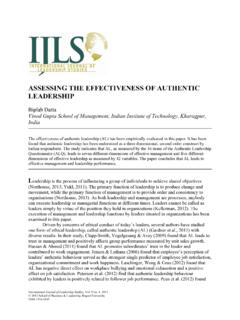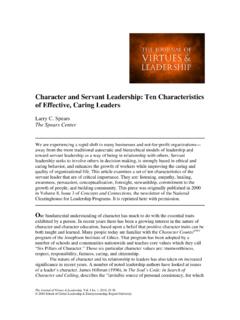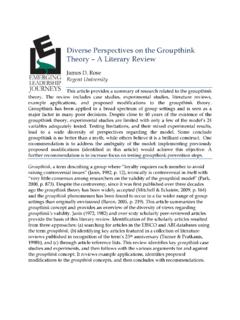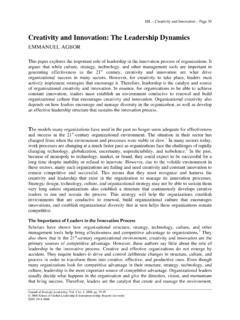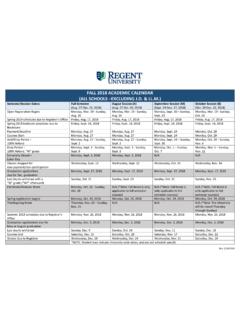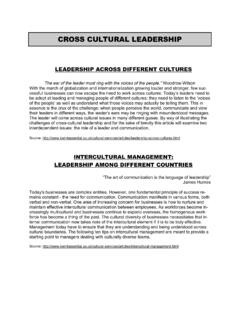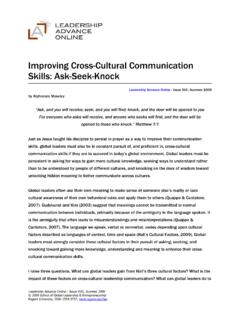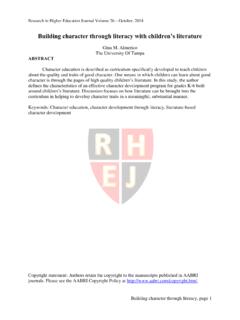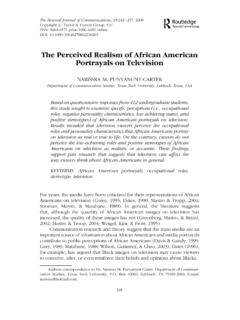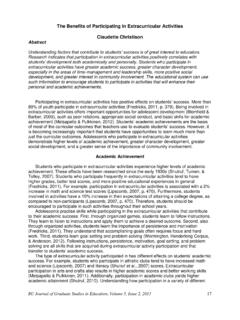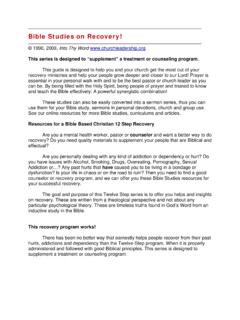Transcription of Character and Servant Leadership: Ten Characteristics of ...
1 Character and Servant leadership : Ten Characteristics of Effective, Caring Leaders Larry C. Spears The Spears Center We are experiencing a rapid shift in many businesses and not-for-profit organizations . away from the more traditional autocratic and hierarchical models of leadership and toward Servant leadership as a way of being in relationship with others. Servant leadership seeks to involve others in decision making, is strongly based in ethical and caring behavior, and enhances the growth of workers while improving the caring and quality of organizational life. This article examines a set of ten Characteristics of the Servant leader that are of critical importance. They are: listening, empathy, healing, awareness, persuasion, conceptualization, foresight, stewardship, commitment to the growth of people, and building community. This piece was originally published in 2000. in Volume 8, Issue 3 of Concepts and Connections, the newsletter of the National Clearinghouse for leadership Programs.
2 It is reprinted here with permission. Our fundamental understanding of Character has much to do with the essential traits exhibited by a person. In recent years there has been a growing interest in the nature of Character and Character education, based upon a belief that positive Character traits can be both taught and learned. Many people today are familiar with the Character Counts!(sm). program of the Josephson Institute of Ethics. That program has been adopted by a number of schools and communities nationwide and teaches core values which they call Six Pillars of Character . Those six particular Character values are: trustworthiness, respect, responsibility, fairness, caring, and citizenship. The nature of Character and its relationship to leaders has also taken on increased significance in recent years. A number of noted leadership authors have looked at issues of a leader's Character . James Hillman (1996), in The Soul's Code: In Search of Character and Calling, describes the invisible source of personal consistency, for which The Journal of Virtues & leadership , Vol.
3 1 Iss. 1, 2010, 25-30. 2010 School of Global leadership & Entrepreneurship, Regent University Spears/JOURNAL OF VIRTUES & leadership 26. I am using the word `habit,' psychology today calls Character . Character refers to deep structures of personality that are particularly resistant to change (p. 260). The literature on leadership includes a number of different listings of Character traits as practiced by leaders. I particularly like Warren Bennis's (1989) short list as contained in his book, On Becoming a Leader, in which he identifies, vision, inspiration, empathy and trustworthiness as key Characteristics of effective leaders (p. 140). Much of the leadership literature includes as an implicit assumption the belief that positive Characteristics can-and-should be encouraged and practiced by leaders. Robert K. Greenleaf, the originator of the term, Servant leadership , is someone who thought and wrote a great deal about the nature of Servant leadership and Character .
4 Servant leadership and Character The Servant -leader is Servant first. It begins with the natural feeling that one wants to serve. Then conscious choice brings one to aspire to lead. The best test is: do those served grow as persons: do they, while being served, become healthier, wiser, freer, more autonomous, more likely themselves to become servants ? And, what is the effect on the least privileged in society; will they benefit, or, at least, not be further deprived? (Greenleaf, 1977/2002, p. 27). With that definition in 1970, retired AT&T executive Robert K. Greenleaf (1904-1990). coined the term Servant leadership and launched a quiet revolution in the way in which we view and practice leadership . Three decades later the concept of Servant leadership is increasingly viewed as an ideal leadership form to which untold numbers of people and organizations aspire. In fact, we are witnessing today an unparalleled explosion of interest in, and practice of, Servant leadership .
5 We are experiencing a rapid shift in many businesses and not-for-profit organizations away from the more traditional autocratic and hierarchical models of leadership and toward Servant leadership as a way of being in relationship with others. Servant leadership seeks to involve others in decision making, is strongly based in ethical and caring behavior, and enhances the growth of workers while improving the caring and quality of organizational life. The words Servant and leader are usually thought of as being opposites. In deliberately bringing those words together in a meaningful way, Robert Greenleaf gave birth to the paradoxical term Servant leadership . In the years since then, many of today's most creative thinkers are writing and speaking about Servant leadership as an emerging leadership paradigm for the 21st century. The list is long and includes: James Autry, Warren Bennis, Peter Block, John Carver, Stephen Covey, Max DePree, Joseph Jaworski, James Kouzes, Larraine Matusak, Parker Palmer, M.
6 Scott Peck, Peter Senge, Peter Vaill, Margaret Wheatley, and Danah Zohar, to name but a few of today's cutting-edge leadership authors and advocates of Servant leadership . In her groundbreaking book on quantum sciences and leadership , Rewiring the Corporate Brain (1997), Zohar goes so far as to state that, Servant - leadership is the essence of quantum thinking and quantum leadership (p. 146). The Journal of Virtues & leadership , Vol. 1 Iss. 1, 2010, 25-30. 2010 School of Global leadership & Entrepreneurship, Regent University Spears/JOURNAL OF VIRTUES & leadership 27. Ten Characteristics of a Servant Leader After some years of carefully considering Greenleaf's original writings, I have identified a set of ten Characteristics of the Servant leader that I view as being of critical importance central to the development of Servant -leaders. My own work currently involves a deepening understanding of the following Characteristics and how they contribute to the meaningful practice of Servant leadership .
7 These ten Characteristics include: Listening Leaders have traditionally been valued for their communication and decision- making skills. Although these are also important skills for the Servant leader, they need to be reinforced by a deep commitment to listening intently to others. The Servant leader seeks to identify the will of a group and helps to clarify that will. He or she listens receptively to what is being said and unsaid. Listening also encompasses hearing one's own inner voice. Listening, coupled with periods of reflection, is essential to the growth and well-being of the Servant leader. Empathy The Servant leader strives to understand and empathize with others. People need to be accepted and recognized for their special and unique spirits. One assumes the good intentions of co-workers and colleagues and does not reject them as people, even when one may be forced to refuse to accept certain behaviors or performance.
8 The most successful Servant leaders are those who have become skilled empathetic listeners. Healing The healing of relationships is a powerful force for transformation and integration. One of the great strengths of Servant leadership is the potential for healing one's self and one's relationship to others. Many people have broken spirits and have suffered from a variety of emotional hurts. Although this is a part of being human, Servant leaders recognize that they have an opportunity to help make whole those with whom they come in contact. In his essay, The Servant as Leader, Greenleaf (1977/2002). writes, There is something subtle communicated to one who is being served and led if, implicit in the compact between Servant -leader and led, is the understanding that the search for wholeness is something they share (p. 50). Awareness General awareness, and especially self-awareness, strengthens the Servant -leader. Awareness helps one in understanding issues involving ethics, power, and values.
9 It lends itself to being able to view most situations from a more integrated, holistic position. As Greenleaf (1977/2002) observed: Awareness is not a giver of solace it is just the The Journal of Virtues & leadership , Vol. 1 Iss. 1, 2010, 25-30. 2010 School of Global leadership & Entrepreneurship, Regent University Spears/JOURNAL OF VIRTUES & leadership 28. opposite. It is a disturber and an awakener. Able leaders are usually sharply awake and reasonably disturbed. They are not seekers after solace. They have their own inner serenity (p. 41). Persuasion Another characteristic of Servant leaders is reliance on persuasion, rather than on one's positional authority, in making decisions within an organization. The Servant leader seeks to convince others, rather than coerce compliance. This particular element offers one of the clearest distinctions between the traditional authoritarian model and that of Servant leadership .
10 The Servant leader is effective at building consensus within groups. This emphasis on persuasion over coercion finds its roots in the beliefs of the Religious Society of Friends (Quakers) the denominational body to which Robert Greenleaf belonged. Conceptualization Servant leaders seek to nurture their abilities to dream great dreams. The ability to look at a problem or an organization from a conceptualizing perspective means that one must think beyond day-to-day realities. For many leaders, this is a characteristic that requires discipline and practice. The traditional leader is consumed by the need to achieve short-term operational goals. The leader who wishes to also be a Servant leader must stretch his or her thinking to encompass broader-based conceptual thinking. Within organizations, conceptualization is, by its very nature, a key role of boards of trustees or directors. Unfortunately, boards can sometimes become involved in the day-to-day operations something that should be discouraged and, thus, fail to provide the visionary concept for an institution.
